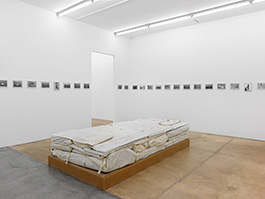
| français I english |
| Collections / October 12, 2016— |
|
Franz Erhard Walther |
“The viewer who acts defines the work of art and answers for it; he or she cannot be involved solely as someone who is looking at something; their entire body is engaged.” This declaration by Franz Erhard Walther (1939, Germany) suggests the framework in which part of his artistic output exist, that is, in which it is truly put to work or takes shape. It is in fact with the body of the person who activates the piece, who makes it come alive, that art assumes both its full meaning for Walther, and its place in the overall sum of activities embraced by the human subject. It was in 1963 that Walther laid out this physical, participatory dimension of his work, specifically of his sculpture, which the artist qualifies as ‘objects’, thus underscoring their instrumental character. In that year the artist debuted a group of pieces under the title 1. Werksatz [Work Series No. 1]. To create these pieces, Walther decided he would no longer operate from a system of forms that was shut up on itself—artifacts that were meant to be looked at only and which the viewer was never to take in hand—but according to processes and gestures that would be unique each time, never set in stone once and for all. The objects he was to produce would be means to an impetus. These objects adopt simple geometric shapes (rectangles, squares, lines, circles, etc.) and are made of cloth, which transforms them into so many waistcoasts, rugs, strips, and so on. The way one takes them in hand is of course up to the individual and remains undecidable. In each case it is viewers’ bodies that become the means for activating, revealing or inventing the formal possibilities that are specific to these sculptural objects. Each time it is the acting individual who invents the profile and use of these available forms. The decision to employ cloth, a malleable material that has of course a certain configuration but can also be shaped according to the actions of the operator (folding, unfolding, clothing the individual), makes the physical reappropriation of the sculpture easier. It makes possible the ‘return to square one, where nothing has shape and everything begins to take shape once again’, which Walther seeks to encourage. Or in other words, it allows the body to experience the genesis of the sculpture, to feel the very process of the appearance of a form. Through this encouraged connection with the body, an action that thus lends the work all of its formal impact, an act that creates the sculpture, the artist ‘shows that it is not only our visual perception that is worthwhile but the body that has a certain sense and significance.’In other words, to borrow the title of a book devoted to Walther, it is indeed with the body in this instance that one must see (and create the work of art). This situation gives rise to several important consequences. Unlike one tradition in the West, which has its roots in Platonic philosophy and for which art is a matter of the eye pure and simple, art is a field that is exclusively optical—this is the meaning of Leonardo’s famous definition of it as cosa mentale—in other words, unlike the status that history reserves for the Western viewer, conceived as an eye without a body (the eye of the soul), Walther ties the use of vision to the reality of the embodiment, thus making the tactile dimension of the works something fundamental. This amounts to a major historic and esthetic break. Secondly the fact that the body, its gestures and poses create the piece, transforms the body into a processual device in which time plays a crucial role. The body at work stresses the temporary-object aspect of the sculpture. Finally, with his works from the early 1960s, Walther joins a certain number of artists who, during the same period, were turning out scultpures that were not only activated by viewers but indeed configured by them. There was, for instance, the Brazilian artist Lygia Clark, who began her series of Bichos in 1960, metallic structures that can be manipulated and boast no single, permanently fixed shape. Like Clark, Walther has explored and invented the faces of artworks that are destined to remain eternally available, that is, forms that are constantly assuming new forms and are therefore—provided that someone takes them in hand—endlessly being invented and reinvented. Or we might say the German artist has created open works of art, the term coined by the semiotician Umberto Eco in a famous book published in 1962, in other words, just one year before Walther begans his Work Series No.1. |
| |
 |
|
Franz Erhard Walther, 1. Werksatz, 1963-1969, |